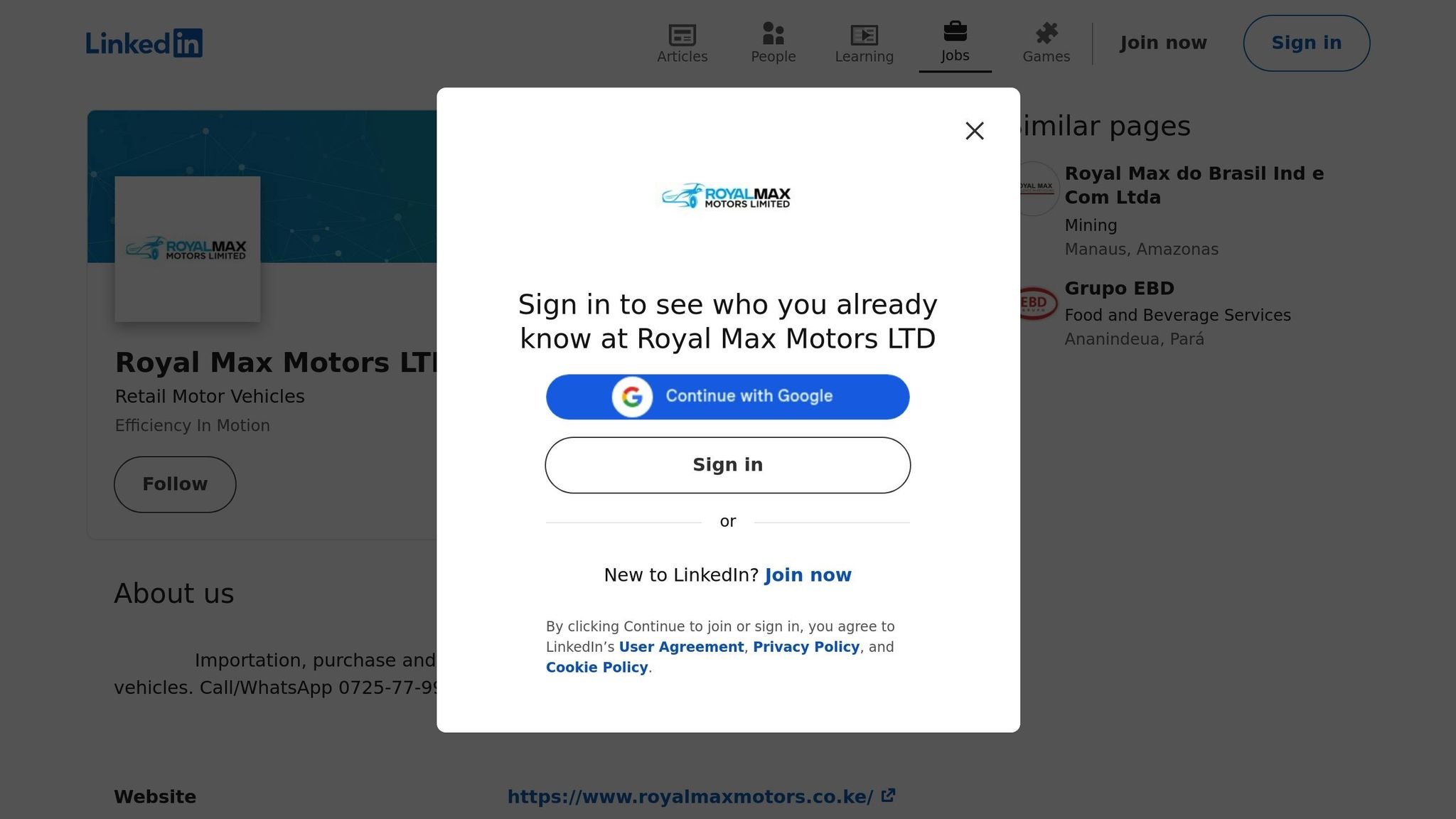Want to buy your first car in Kenya but worried about financing? Here’s a quick guide to help you navigate the process and make smart decisions:
- Financing Options: Choose from bank loans, SACCO financing, dealership financing, or microfinance institutions. Each option has unique terms, interest rates, and requirements.
- Documents You’ll Need: Be ready with your ID, KRA PIN, bank statements, payslips (for salaried employees), or business records (for entrepreneurs).
- Interest Rates: SACCOs often offer the lowest rates (8%-12%), while banks and microfinance institutions range from 12%-20%.
- Key Tips: Use the 20/4/10 rule – 20% down payment, a 4-year loan term, and car expenses under 10% of your income. Avoid balloon payments and hidden fees.
| Option | Interest Rate | Max Financing | Requirements |
|---|---|---|---|
| Bank Loans | 12%-15% | 90% of car value | Good credit, income proof |
| SACCO Financing | 8%-12% | Up to 100% | SACCO membership, savings |
| Dealership Loans | 12%-18% | Up to 100% | ID, KRA PIN, income proof |
| Microfinance | 14%-20% | Up to 100% | ID, bank statements |
Pro Tip: Compare interest rates, APR, and total costs before committing to a loan. Plan your finances carefully to avoid borrowing more than you can afford.
Ready to dive deeper? Let’s break down the details.
How Car Financing Works in Kenya – Bob Wa Magari Visits Royal Max Motors | #SpaceYaMagari

Car Financing Options in Kenya
Kenya provides a variety of car financing solutions, each with its own impact on your monthly payments and overall costs. Knowing how these options differ can help you choose the one that aligns with your financial needs.
Bank Loans
Banks remain a go-to option for car financing in Kenya. They allow you to take ownership of the vehicle immediately, financing up to 90% of its value with repayment terms ranging from 12 months to 5 years. However, this convenience comes with strict requirements. You’ll need to be at least 18 years old, have a stable income (proven through bank statements and payslips), maintain a good credit score, and provide a valid Kenyan ID or passport.
Some banks have sped up their processes, offering loan approvals in as little as 12 hours. They can finance up to 10 million KSh (around $74,627) for new cars or 5 million KSh (about $37,313) for used ones. That said, the approval process can still be lengthy, and their eligibility criteria are rigorous due to detailed credit checks and income verification.
SACCO Financing
Savings and Credit Cooperative Societies (SACCOs) are known for offering some of the most appealing car financing rates in Kenya. With repayment terms of up to 6 years and even zero deposit options, they stand out as a budget-friendly choice.
To qualify, you must be an active SACCO member for at least 6 months, maintain consistent savings or shares, and provide documents like salary slips or proof of business income, along with CRB clearance. Since SACCOs are member-owned, they often provide a more personalized experience.
For first-time car buyers who are SACCO members – or can join one – this option is particularly attractive due to its lower interest rates and flexible terms.
Dealership and Microfinance Options
Car dealerships often collaborate with financing companies to offer in-house financing solutions. These arrangements are convenient, with streamlined processes, and some dealerships even provide zero deposit options and immediate car ownership once the agreement is signed.
Microfinance institutions have also entered this space, offering competitive rates and financing for various vehicle types. Many providers offer faster approval and can finance up to 100% of a car’s value. However, these options typically come with higher interest rates.
While dealership and microfinance financing can be quicker and have less stringent credit requirements, they may limit your choice of lenders and often include balloon payments, which can increase your overall costs.
| Financing Option | Interest Rate Range | Maximum Financing | Key Requirements |
|---|---|---|---|
| Bank Loans | 12% – 15% per year | Up to 90% of car value | Good credit score, stable income, 18+ years |
| SACCO Financing | 8% – 12% per year | Up to 100% (in some cases) | Active membership (6+ months), consistent savings |
| Dealership Financing | 12% – 18% per year | Up to 100% of car value | Valid ID, KRA PIN, proof of income |
| Asset Financing | 14% – 20% per year | Up to 100% of car value | Valid ID, consistent income, bank statements |
When deciding, consider factors like your credit score, SACCO membership, and how quickly you need the car. SACCOs often offer the lowest rates, banks provide a full range of services, and dealership financing is the fastest way to get behind the wheel. Up next, we’ll cover how to prepare your loan application to secure the best terms.
How to Prepare Your Loan Application
Getting your loan application in order takes careful planning. A well-prepared application can increase your chances of getting better terms and a quicker approval.
Required Documents
The documents you’ll need depend on whether you’re a salaried employee or a business owner. Organizing these ahead of time can save you from unnecessary delays.
For salaried employees, you’ll need your national ID or passport, a KRA PIN certificate, and six months of bank statements. Additionally, your employer must provide recent payslips and a letter confirming your employment status and salary. Don’t forget a proforma invoice from the car dealer, which includes details and the price of the vehicle.
For business owners, the requirements are a bit more extensive. Along with your national ID and KRA PIN, you’ll need business registration certificates, audited financial statements for the past two years, and detailed bank statements showing consistent cash flow. Some lenders may also ask for a tax compliance certificate and business permits.
Most lenders will pull a credit report to evaluate your creditworthiness. This report reflects your borrowing history and plays a role in determining your interest rate. If you haven’t checked your credit score recently, it’s a good idea to review it for any errors before applying.
To avoid missing anything, reach out to your chosen lender for their specific checklist.
| Document Type | Salaried Clients | Business Clients | Where to Obtain |
|---|---|---|---|
| Identity | National ID/Passport | National ID/Passport | Huduma Centers, Immigration Dept |
| Tax Compliance | KRA PIN Certificate | KRA PIN + Tax Compliance Certificate | KRA iTax Portal |
| Income Proof | 3 months of payslips and employment letter | Audited financial statements (2 years) | Employer/Certified Accountant |
| Banking | 6 months bank statements | 12 months bank statements | Your bank branch/online |
| Vehicle Details | Proforma invoice from dealer | Proforma invoice from dealer | Car dealership |
Once your documents are ready, take a step back and evaluate your financial situation.
Check Your Financial Readiness
Before submitting your application, it’s crucial to assess your financial health.
A helpful guideline is the 20/4/10 rule: aim for a 20% down payment, a four-year repayment plan, and keep car-related expenses under 10% of your income.
Make sure your down payment and loan won’t interfere with other financial goals. It’s also important to have a stable income during the loan term. If you’re on probation at work, considering a job change, or experiencing irregular business income, it might be better to wait until your situation stabilizes.
Plan for ongoing expenses and maintain an emergency fund that covers 3–6 months of living costs. Additionally, aim to save at least 10% (or ideally 20%) of your monthly income after factoring in all car-related expenses to ensure financial security.
Dennis Birai, CEO of Gybird Motors, offers this advice: “When considering purchasing your first car, look for a dealership with a good reputation… Take your time to research, make sure you’re getting a car you love that fits your budget, and always buy from a dealership with a physical location”.
sbb-itb-e5ed0ed
How to Review Loan Terms and Conditions
Once you’ve prepared your application, the next step is to dive into the details of your loan terms. These terms can have a big impact on the overall cost of your loan, so understanding them upfront is key to avoiding unexpected expenses.
Fixed vs. Reducing Balance Interest Rates
The type of interest rate your lender uses plays a huge role in determining how much you’ll pay back over time. In Kenya, you’ll typically come across two types: fixed interest rates and reducing balance interest rates.
Fixed interest rates stay the same throughout the loan’s term. This means your payments remain consistent, making them easier to predict.
Reducing balance interest rates are calculated based on the remaining principal balance. As the principal decreases with each payment, the interest portion also goes down. Car loans, for example, often use simple interest structures.
| Interest Type | Fixed Rate | Reducing Balance |
|---|---|---|
| Monthly Payment | Consistent amount | May decrease over time |
| Total Interest Paid | Could be higher overall | Generally lower over the loan term |
| Budgeting | Easier to plan | Requires flexibility for changes |
| Best For | Predictable payments | Lower total interest costs |
Hidden Costs and Fees
Loan agreements often include additional fees that can add to the overall cost. One fee to watch out for is the prepayment penalty, which some lenders charge if you decide to pay off your loan early. This can reduce or even eliminate the financial benefit of early repayment.
"The APR is a broader measure of the cost to you of borrowing money since it reflects not only the interest rate but also the fees that you have to pay to get the loan. The higher the APR, the more you’ll pay over the life of the loan." – Consumer Financial Protection Bureau
When comparing loan offers, focus on the Annual Percentage Rate (APR) rather than just the interest rate. The APR gives you a fuller picture, as it includes both the interest rate and any associated fees.
Before you sign anything, ask your lender for a detailed breakdown of all fees in writing. Having this information will make it easier to factor these costs into your budget and avoid surprises down the road.
Next, we’ll look at common financing mistakes and how to avoid them.
Common Car Financing Mistakes to Avoid
Buying a car for the first time can be exciting, but it’s also easy to make decisions that lead to financial headaches. Knowing what to watch out for can save you from unnecessary stress and help you make smarter choices.
Borrowing Too Much Money
One of the most common mistakes people make is borrowing more than they can comfortably afford. Taking on a loan that stretches your budget too thin can put your financial health at risk. High monthly payments can leave little room for other essential expenses.
Before signing on the dotted line, take a close look at your income and expenses to figure out what loan amount works for you. Lenders usually calculate your debt-to-income (DTI) ratio – your monthly bills divided by your pre-tax income – to assess how much you can borrow. If your DTI ratio is too high, you might need to increase your down payment, pay off some existing debts, or even wait until your financial situation improves.
Miller Kyalo, a car expert and automotive engineer, offers this advice:
"If you know you’re a small businessman, and you don’t have a stable source of income, don’t commit to a loan."
Another potential pitfall involves balloon payments and financing terms that come with hidden risks.
Balloon Payments and Loan Restrictions
Financing models with hidden costs, like balloon payments, are another trap for first-time buyers. A balloon payment is a large, one-time amount due at the end of your loan term. While the smaller monthly payments might seem appealing, the final payment can be as much as 45%–60% of the car’s value. These loans often come with higher interest rates than traditional auto loans, and if you can’t meet the final payment, you risk losing your car and damaging your credit score.
Here’s a quick comparison of traditional auto loans and balloon payment loans:
| Traditional Auto Loan | Balloon Payment Loan |
|---|---|
| Equal monthly payments throughout | Lower monthly payments with a large final payment |
| Lower interest rates | Higher interest rates |
| Predictable payment schedule | Risk of a sizeable final payment |
| Builds equity steadily | Limited equity until the final payment |
Additionally, avoid loans where the vehicle serves as unchangeable collateral. If you miss payments, repossession could follow, leaving you in a worse financial position.
Instead of restrictive dealer financing, you might want to explore options like SACCO loans, which often come with more flexible terms and lower risks. Comparing different loan options, including their features and interest rates, can help you make a better-informed decision.
Another mistake to avoid is focusing only on monthly payments without considering the total cost of the vehicle and loan terms. This approach can lead to overpaying or agreeing to unfavorable conditions. To sidestep this, negotiate the car’s price and financing terms separately. Getting pre-approved for a loan through your bank or SACCO can also clarify your borrowing power and give you an edge when negotiating.
Conclusion
Getting your first car loan in Kenya can feel like a big step, but it’s much easier to handle with a solid plan. Start by setting a clear and realistic budget that leaves room for your everyday expenses and any unexpected costs. Then, shop around and compare offers from different lenders to find terms that align with your financial situation.
Pre-approval is a smart move – it not only helps you understand how much you can borrow but also strengthens your position when negotiating. Pay close attention to the Annual Percentage Rate (APR) to get a full picture of borrowing costs. For example, SACCOs typically offer interest rates between 8% and 12% per year, while asset financing companies may charge higher rates, ranging from 14% to 20%. Don’t just focus on the monthly payment; make sure you understand the total cost of the loan. And always read the fine print before signing anything.
Avoid common mistakes like borrowing more than you can comfortably repay or falling for balloon payment schemes that seem appealing at first but can lead to trouble down the road. Opting for a used car can also stretch your money further, but be sure to have a trusted mechanic inspect it before buying.
Lastly, a good credit score and stable finances go a long way in securing better loan terms. Work on maintaining a strong credit history, show consistent income, and save up for a sizable down payment to improve your chances of getting favorable rates. By following these steps, you’ll be well-prepared to secure financing that works for you.
FAQs
What are the pros and cons of using SACCO financing instead of a bank loan to buy your first car in Kenya?
SACCO financing offers a practical route for first-time car buyers in Kenya, but it’s essential to weigh its benefits and limitations before diving in.
On the upside, SACCOs often provide lower interest rates compared to traditional banks, making loans more affordable. They also offer flexible repayment terms and typically have less demanding collateral requirements, which can make it easier for more people to qualify.
However, there are challenges to consider. Loan amounts from SACCOs are often limited, meaning they might not cover the full cost of your car. Additionally, you’ll need to be a member of the SACCO, which usually involves saving with them first before you can access a loan.
While SACCO financing is a budget-friendly option, it’s not a one-size-fits-all solution. Your financial circumstances and specific needs will determine if it’s the right choice for you.
What can I do to improve my chances of getting a car loan with a low credit score?
If your credit score isn’t where you’d like it to be, there are ways to improve your chances of securing a car loan. One effective step is to make a larger down payment. This reduces the amount you’ll need to borrow and signals to lenders that you’re committed to the purchase. Another helpful approach is finding a co-signer with strong credit, which can give lenders more confidence in your ability to repay.
Before you apply, take the time to review your credit report for any errors that might be dragging your score down. Addressing inaccuracies and paying down existing debts can also help improve your credit profile. Additionally, look into lenders who specialize in working with borrowers who have less-than-stellar credit. These steps can help position you as a more appealing candidate and boost your chances of getting approved.
What’s the difference between a fixed interest rate and a reducing balance interest rate for car loans?
When deciding between a fixed interest rate and a reducing balance interest rate for your car loan, it’s essential to know how each option works and how it affects your payments.
A fixed interest rate remains constant throughout the loan term, which means your monthly payments will stay the same. This consistency can make budgeting much easier. In contrast, a reducing balance interest rate is calculated on the outstanding loan amount. As you pay down the principal, the interest decreases, which often leads to lower total interest costs but can result in monthly payments that vary over time.
Your choice should align with your financial situation and repayment priorities. If you value predictable payments and straightforward planning, a fixed rate might be the better option. However, if saving on total interest is your goal and you’re comfortable with fluctuating payments, a reducing balance rate could work in your favor.
Related posts
- Car Loan Eligibility in Kenya: Key Factors
- Car prices in Nairobi 2025
- Where to buy certified used cars in Kenya
- Step-by-Step Guide to Buying a Car in Kenya (2025 Edition)




